Mary Anne Yarde's Blog: The Coffee Pot Book Club , page 116
November 1, 2019
#BookReview — The Raided Heart (Historic Hearts, #1) by Jennifer C. Wilson #HistoricalRomance #NewRelease @inkjunkie1984
 The Raided Heart (Historic Hearts, #1)By Jennifer C. Wilson
The Raided Heart (Historic Hearts, #1)By Jennifer C. Wilson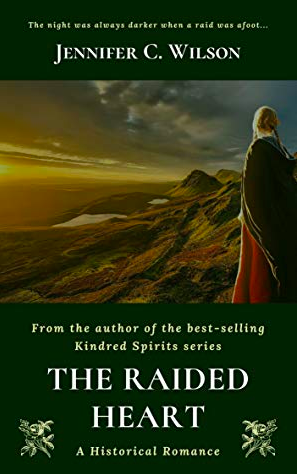
Meg Mathers, the headstrong youngest sibling of a reiving family on the English-Scottish border, is determined to remain at her childhood home, caring for the land and village she’s grown up with. When an accident brings her a broken ankle and six weeks in the resentful company of ambitious and angry young reiver Will Hetherington, attraction starts to build. Both begin to realise they might have met their match, and the love of their lives, but 15th century border living is not that simple, as Meg soon finds herself betrothed to the weakling son of a tyrannical neighbour, Alexander Gray. When tragedy strikes, can Meg and Will find their way back to each other, and can Will finally take his own personal revenge on Gray?
The Raided Heart is the first of "The Historic Hearts", a collection of historical romantic adventures set in Scotland and the North of England.

“We can’t, Meg, we can’t...”
Meg Mathers knows — she knows that they can’t. But her heart seems to have no understanding of the word duty. Her heart belongs to Will Hetherington’s, and nothing can change that. Nothing.
However, these are dangerous times, and to survive Long Ridge must make alliances, and no one is as powerful as the tyrannical Alexander Grey of Cliffside. Everyone thinks they know what Grey is capable of, but it is better to have him as an ally than an enemy. But Will knows Grey more intimately than others, and he has vowed to one day have his revenge on the man who murdered his parents.
Although her heart is forever Will’s, Meg has no choice but to agree to a betrothal to Grey’s eldest son. Meg’s brothers demand it from her for they need the alliance. She must marry him. A broken heart is a small price to pay if it means that those who Meg cares about are safe. And perhaps it will not be that bad. Perhaps the story of Grey has been exaggerated, and it is not like Meg is marrying him. She is marrying his son.
Will fears for Meg, but there is nothing he can do. He cannot marry Meg himself, for he is nothing, a no-one. And yet, he cannot let her go to Cliffside alone, for Grey has a reputation for brutality. Will has to be there for Meg in case the worst happens. He will protect her, this he vows.
From the relative safety of Long Ridge, Northumberland and a forbidden first love, to the danger of Cliffside and the tyrannical Alexander Grey, The Raided Heart (Historic Hearts, #1) by Jennifer C. Wilson is a story that threatens to mesmerise the reader and leave them gasping for more.
The Raided Heart is a wonderfully tender romance set within a backdrop of hostility and questionable allegiances. With the ever-present threat of danger, Wilson has penned a story that is not only tautly gripping but one that is impossible to resist, let alone put down. The narrative of this engrossing romance is fast-paced, and the non-stop action kept me not only engaged throughout, but eagerly turning the pages to find out what was going to happen next.
Meg is a strong heroine who, despite the constraint of her times and the lack of control over her own life, tries to make the best of it. She is incredibly brave but always willing to compromise. Meg is initially reluctant to start any kind of relationship with Will, knowing that they can never be together, but when her heart takes over, when she realises that this attraction between them cannot be denied, then she is Will’s — whether she is married to someone else or not, she will always be Will’s. I thought Meg's portrayal was perfect.
Will. Oh, Will. How I adored the hero of this story. It is all so terribly romantic, and Will is just fabulous. I was utterly captivated by Will. He is a marvellous example of what a historical romance hero should be. Will is a very capable man, who has had so much tragedy in his life and yet, his capacity to love is infinite. He adores Meg and knowing he cannot have her made his love somehow stronger. He risks so much for Meg, but he does so willingly. Will’s portrayal was undoubtedly the driving force in this story that kept me enthralled.
The historical detailing of this book has to be commended. I truly felt as if I were living in the borders of Scotland and England during the 15th Century. This was a brutal time, with the threat of war and starvation ever-present. I thought Wilson really captured the essences of the era.
If you are looking for your next tender historical romance, then look no further than The Raided Heart (Historic Hearts, #1) by Jennifer C. Wilson. I, for one, cannot wait to read the second book in what promises to be a fantastic series.
I Highly Recommend.
Review by Mary Anne Yarde.The Coffee Pot Book Club.
Pick up your copy ofThe Raided HeartAmazon UK • Amazon US
Jennifer C. Wilson
 Jennifer is a marine biologist by training, who developed an equal passion for history whilst stalking Mary, Queen of Scots of childhood holidays (she since moved on to Richard III). She completed her BSc and MSc at the University of Hull, and has worked as a marine environmental consultant since graduating.
Jennifer is a marine biologist by training, who developed an equal passion for history whilst stalking Mary, Queen of Scots of childhood holidays (she since moved on to Richard III). She completed her BSc and MSc at the University of Hull, and has worked as a marine environmental consultant since graduating. Enrolling on an adult education workshop on her return to the north-east reignited Jennifer’s pastime of creative writing, and she has been filling notebooks ever since. In 2014, Jennifer won the Story Tyne short story competition, and also continues to work on developing her poetic voice, reading at a number of events, and with several pieces available online. Her Kindred Spirits novels are published by Crooked Cat Books, alongside a self-published timeslip novella.
She is also a co-founder and host of the award-winning North Tyneside Writers' Circle, and has hosted various events and workshops across the Tyneside area.
Connect with Jennifer: Website • Twitter • Goodreads • Amazon Author Page.
Published on November 01, 2019 22:00
#BookReview — Serpents in the Garden (The Graham Saga #5) by Anna Belfrage #HistoricalFiction #TimeTravel @abelfrageauthor
 Serpents in the Garden(The Graham Saga #5)By Anna Belfrage
Serpents in the Garden(The Graham Saga #5)By Anna Belfrage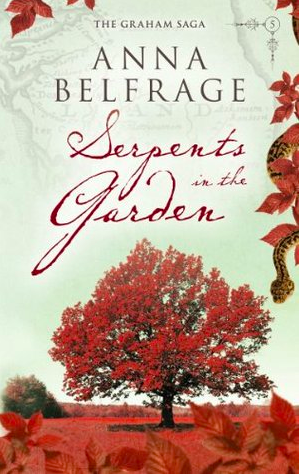
After years of hard work, Matthew and Alex Graham have created a thriving home in the Colony of Maryland. About time, in Alex’s opinion, after far too many adventures she is really looking forward to some well-deserved peace and quiet.
A futile hope, as it turns out. Things start to heat up when Jacob, the third Graham son, absconds from his apprenticeship to see the world – especially as Jacob leaves behind a girl whom he has wed in a most irregular fashion.
Then there’s the infected matter of the fellow time traveller Alex feels obliged to help – no matter the risk. Worst of all, one day Philip Burley and his brothers resurface after years of absence. As determined as ever to make Matthew pay for every perceived wrong – starting with the death of their youngest brother – the Burleys play out a complicated cat and mouse game, and Alex is thrown back into an existence where her heart is constantly in her mouth, convinced as she is that one day the Burleys will achieve their purpose.
Will the Burleys succeed? And if they do, will the Graham family survive the exacted price?

"I avenge my own. Best you don't forget that, aye?"
It had been years. So many years. So much resentment and hatred. Luke Graham should despise his brother's son, his nephew, but he did not. How could he? Jacob was a likeable young man, and he got on well with Luke's own son. Perhaps it was time to let bygones be bygones.
Philip Burley and his brothers, however, were determined to be avenged. Matthew Graham would die by their hands, for they had made a vow, and it was one that they intended to keep. Matthew was living on borrowed time, as was his wife, Alex. The Burley brothers would have their revenge in blood.
Matthew knew this day would come. They were always there, the Burleys', in the back of his mind. They had tried to kill him once. They would try again. It was just a question of when.
Alec Graham had thought all of her mother's paintings had been destroyed. There would be no more slipping through time, for anyone ever again. But then she hears a tale of a young man of colour, who claims he is a free man. Who claims to be equal to his white counterparts. Who claims to have fallen through time. Alex refuses to look the other way. She must help him, free him from the bonds of servitude. But at what cost to herself?
From a hastily muttered handfasting to a wedding built on a foundation of happiness and love, Serpents in the Garden (The Graham Saga #5) by Anna Belfrage is an undeniable historical time-travel triumph.
This series keeps getting better and better. Belfrage writes with such energy and such imagination that it is as if I have been swept up and transported back in time as quickly and as effortlessly as if I had fallen through one of Mercedes' magical paintings. I am beginning to wonder if The Graham Saga is indeed a time portal, for as soon as I began to read, time ceased to matter. I became fully invested in the lives of these characters and the era that it is set in. This is as close to time-travel as any reader could ever hope.
Having read this series from the beginning, it is like meeting up with old friends. Many years have passed by since Book 1, and the characters have aged. And with age comes maturity, ill-health for some, and for Matthew and Alex a mature, yet inspirational love. Their story is fresh, tantalisingly gripping, and one that I don't want to come to an end. But what I especially loved was how their children have grown up and found their own way, and are telling their own story. I cannot get enough of the Graham family. Belfrage is a storyteller that knows how to get her readers hooked and, more importantly, keep them hooked and begging for more.
Matthew and Alex are still the main characters in this novel, but there are several sub-plots with their grown-up children that bewitched me. Firstly, there is young Jacob — an adventure, a risk-taker. However, at the same time, he wants to make his parents proud — he wants to be someone. Jacob is an idealist, perhaps even a dreamer, and he can be incredibly innocent and naive as to the way the world works. But he has such a good heart and is always full of good intentions — even if sometimes those intentions rebounded. I thought Jacob was fabulous, and I enjoyed reading about him.
Another character who intrigued me in this book was Luke Graham. Luke has always been the antagonist in this story. He has done some wicked things to his brother, but there were moments in this book where I found myself almost liking him. Luke becomes this anti-hero. Belfrege lets us glimpse at this other side to his character — that character that Margaret so desperately loved. I am really glad Belfrage did this and gave Luke a platform in which to tell his side of the story. Don't get me wrong, he is still despicable, and he cannot negate his past, but he is not all bad either.
Ian, since he was introduced as this little boy who was unsure who his birth father was, has always been one of my favourite characters. Belfrage is not kind to him. He goes through Hell, not once but twice, and yet Ian still maintains this air of compassion. He is wronged dreadfully in this story, and yet he does not become bitter. Ian's capacity for love and his empathy towards others makes him one of those unforgettable characters. I truly hope Ian has an easier time in Book 6!
The Burley brothers are still in fine form — causing fear, anguish and suffering. How I detest them. They have no redeemable qualities at all. They are loathsome, and I genuinely feared where it was going to end. Belfrage is very good at penning contemptible villains.
The historical backdrop to this story is balanced incredibly well with the narrative. Belfrage seemingly writes effortlessly, but of course, to be able to do that means that Belfrage has certainly done her homework. The hours of research that Belfrage has devoted to this era has to be commended because Belfrage does not limit herself to one country — London, Scotland, The Colony of Maryland, and Virginia are all represented in this story. It is such a vast historical canvas, but Belfrage has not only pulled it off, but she has excelled at it. I take my hat off to you, Ms Belfrage, you are an exceptional writer and an outstanding historian.
This series is not losing any of its momenta. I adored every sentence, every word, every syllable of Serpents in the Garden (The Graham Saga #5). Historical time-travel does not get better than this.
I Highly Recommend.
Review by Mary Anne Yarde.The Coffee Pot Book Club.
Pick up your copy ofSerpents in the GardenAmazon UK • Amazon US
Anna Befrage
 Had Anna been allowed to choose, she’d have become a time-traveller. As this was impossible, she became a financial professional with two absorbing interests: history and writing. Anna has authored the acclaimed time travelling series The Graham Saga, set in 17th century Scotland and Maryland, as well as the equally acclaimed medieval series The King’s Greatest Enemy which is set in 14th century England. She has recently released the first in a new series, The Wanderer. This time, she steps out of her normal historical context and A Torch in His Heart is with a fast-paced contemporary romantic suspense with paranormal and time-slip ingredients.
Had Anna been allowed to choose, she’d have become a time-traveller. As this was impossible, she became a financial professional with two absorbing interests: history and writing. Anna has authored the acclaimed time travelling series The Graham Saga, set in 17th century Scotland and Maryland, as well as the equally acclaimed medieval series The King’s Greatest Enemy which is set in 14th century England. She has recently released the first in a new series, The Wanderer. This time, she steps out of her normal historical context and A Torch in His Heart is with a fast-paced contemporary romantic suspense with paranormal and time-slip ingredients.Find out more about Anna by visiting her website, or herAmazon page.
Published on November 01, 2019 21:00
October 31, 2019
# HistoricalFiction author, Patricia Brandon, is taking a look at The Wampus Cat - An Appalachian Legend #Legends @pgaddisbrandon
The Wampus Cat - An Appalachian LegendBy Patricia Brandon

During the summer of my junior year in college, I had the good fortune to work at an elite camp for girls in the most scenic and pristine part of the mountains of western North Carolina. Other than dorm life, I had never been totally on my own, knowing no one, and certainly never lived outside of my hometown. But I adapted quickly, as challenging outdoor and social experiences abounded, surpassed only by the bonds and revelry we made together. Camp Merrie Woode was - and still is - a most remarkable place where girls are encouraged to become women of character and courage.
Camp life was steeped in many traditions, rituals, and legends, but perhaps none more interesting than that of the mysterious and wily Wampus Cat. A cat-like creature that could run on all fours, as an animal, or upright, as a human, it was said to appear after dark, or just before dawn. No one knew for certain when the Wampus Cat would strike, but it was most always after a new experience or achievement, such as a first river run in a canoe or kayak, or the first overnight wilderness camp out or hike. The Wampus Cat would sneak about, planting a kiss on the noses of campers that would leave a large round, very orange dot on nose tips that strangely resembled the odious mercurochrome, used back in the day to treat minor cuts and scrapes. Being graced by the Wampus was no small honor. Years later, my own children were kissed by the creature on their first family camping trip. So how did the Wampus Cat come to roam the highland forests?
In Cherokee folklore, there was once a terrible evil demon, called Ew’ah, or the Spirit of Madness, who lived deep in the mountain woods and terrorized any who heard it’s piercing scream. A single glance from the creature would drive one to madness. The chieftains sent Standing Bear, the fiercest of the braves, to do battle with the Ew’ah. By destroying the demon, he would bring great honor to his family and to the tribe. But weeks later, Standing Bear returned to the tribe screaming in pain, his eyes marred from clawing. Running Deer, his loyal wife, knew that he would never be the same and could no longer be a warrior. By Cherokee law, Standing Bear was now dead to the tribe. Desiring to avenge her husband, Running Deerconvinced the shamans to give her a booger mask of a bobcat’s face, as only the spirit of the mountain cat could defeat the Ew’ah, if she could catch it by surprise. With the mask and black paste on her body to cover her scent, she set out on a most dangerous mission.
After many days she spotted the frightening demon as it drank water from a mountain stream. With great caution she crept up to the evil one and pounced! When the creature saw the cat-spirit-mask, it instantly went mad, throwing itself in the water and thrashing about. Thanks to the courage and bravery of Running Deer, the Ew’ah was no more. The shamans and war chiefs declared her the Spirit Talker and Home Protector. To this day, it is said that the spirit of Running Deer now lives in the Wampus Cat, and that she will forever guard the people and lands of her tribe.
In my next book, also a historical fiction novel, entitled Come Not Down the Lanes , the Wampus Cat will have a small part of the story, which takes place in 1919 in the fictional town of Laurel Valley in western North Carolina. Camp Merrie Woode, the real-life camp for young ladies, was started during this time of Women’s Suffrage, Prohibition, the race riots of Red.
Summer, and the flu pandemic that occurred at the end of World War I. Daily life in the fictional Camp Arden Woode will be largely based on both research from the 1919 era and some of my own experiences there, but with the added twist of an attempted kidnapping in the local town, a murder, and a strange, macabre ritual and character. The story will be one of a coming of age, of immense courage and daring, of mystery and romance, and ultimately, of healing. The book is scheduled for publication in late 2020.
References: Appalachianhistory.net Posted by Dave Tabler, 10/13/17 www.american folklore.net/folktales//tn3.html Enrique de la Viega, Powder Branch, TN, posted 7/1/03, to Ex Libris Nocturnis forum at http://bit.ly/2Fmx4f http://themoonlitroad.com/the-Wampus...- background Mysterious Knoxville by Charles Edwin Price, 1999
The Center of Gravity
By Patricia Brandon
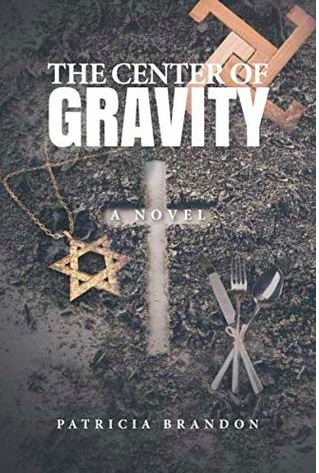
A young woman is tricked into service as a food tester for Adolf Hitler in his secret Wolf's Lair, where she will endure yet another atrocity. A French professor, whose best friend is a Jew fighting in the Alsatian Resistance, is forced to assist in the Nazi reconstruction of the priceless Amber Room in the Konigsberg Castle. All hide dangerous secrets. When their worlds collide, high risk plans for escape are made, with the unlikely help of the anti-Nazi brother of Hermann Goering. But will the darkest of secrets remain hidden, or will lives be forever changed when the truth is finally revealed?
Pick up your copy of
The Center of Gravity
Amazon UK • Amazon US
Patricia Brandon
 Patricia Brandon is a winner of a Carrie McCray Memorial Literary Award and the author of In The Valley Of Achor, her poignant, gritty, and inspirational story of her first year after facing sudden paralysis of her legs. She no longer plays tennis (yet!), but is writing, working on guitar and mountain dulcimer skills, and traveling with friends when she can. She hasn’t given up in the fight to regain her ability to walk!
Patricia Brandon is a winner of a Carrie McCray Memorial Literary Award and the author of In The Valley Of Achor, her poignant, gritty, and inspirational story of her first year after facing sudden paralysis of her legs. She no longer plays tennis (yet!), but is writing, working on guitar and mountain dulcimer skills, and traveling with friends when she can. She hasn’t given up in the fight to regain her ability to walk!Connect with Patricia: Website • Facebook • Twitter.
Published on October 31, 2019 21:00
October 30, 2019
Join #HistoricalFiction author, J.P. Reedman, as she takes a look at the Stories and Stones of Samhain #History #Halloween @StoneLord1
Amazon UK• Amazon US
The Barrow Woman's Bones:A Ghost Story
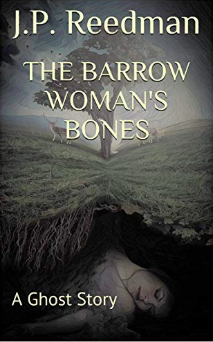
One thundery day in 1909 a Bronze Age burial mound was opened near the sleepy little town of Marlborough. Soon Violet's nights would be disturbed by scratching and tapping. By a horrible, skeletal face pressed to the window.
What did the creature want from a staid old widow? Could Violet ever send this unwanted nightly visitor to eternal rest?
A gentle ghost story based on Wiltshire folkore. Amazon UK • Amazon US
Published on October 30, 2019 22:00
Check out Matthew Lewis' fabulous book — Stephen and Matilda: Cousins of Anarchy #History @MattLewisAuthor
Stephen and MatildaCousins of AnarchyBy Matthew Lewis

The Anarchy was the first civil war in post-Conquest England, enduring throughout the reign of King Stephen between 1135 and 1154. It ultimately brought about the end of the Norman dynasty and the birth of the mighty Plantagenet kings. When Henry I died having lost his only legitimate son in a shipwreck, he had caused all of his barons to swear to recognize his daughter Matilda, widow of the Holy Roman Emperor, as his heir and remarried her to Geoffrey, Count of Anjou. When she was slow to move to England on her father's death, Henry's favourite nephew Stephen of Blois rushed to have himself crowned, much as Henry himself had done on the death of his brother William Rufus. Supported by his brother Henry, Bishop of Winchester, Stephen made a promising start, but Matilda would not give up her birthright and tried to hold the English barons to their oaths. The result was more than a decade of civil war that saw England split apart. Empress Matilda is often remembered as aloof and high-handed, Stephen as ineffective and indecisive. By following both sides of the dispute and seeking to understand their actions and motivations, Matthew Lewis aims to reach a more rounded understanding of this crucial period of English history and asks to what extent there really was anarchy.
Excerpt
In August 1139, Empress Matilda had apparently decided on a radical adjustment in her efforts, though her husband seems to have kept at arms’ length from her new and risky activities. Matilda did not lack an adventurous spirit and demonstrated a willingness to take the fight right to the enemy’s door in an act of daring that would almost certainly have been loudly applauded in a man. It was not a distinction or restriction she was ever to fully acknowledge, at least not for many years. Baldwin de Redvers was sent to secure Wareham Castle in Dorset on the south coast to provide a secure landing spot in England for the empress. Baldwin failed and was forced back to Corfe Castle slightly further inland. His connections in the south-west were letting him down.
Changing her focus, on 30 September 1139, Empress Matilda landed at Arundel Castle near Worthing, further east than Wareham. The castle belonged to William d’Aubigny, who had been created Earl of Sussex (though often referred to as Earl of Arundel) in 1138. William had married Queen Adeliza, the young widow of Henry I who was Empress Matilda’s stepmother. Adeliza was a year younger than her stepdaughter, and it is possible the two had a reasonably good relationship, though they are unlikely to have been close. William was a devoted supporter of King Stephen, so his reception of two of Henry’s children seems odd unless it was at his wife’s instigation. She may have believed she was simply receiving a visit from her stepchildren, or have thought her responsibility still lay in finding a reconciliation between the arguing factions that were emerging. That had been her role as a queen, and she might have believed she could help now, with her husband’s closeness to the king and her own relationship with Henry I’s children.
The Gesta Stephani stated that Robert ‘landed at the castle of Arundel, as though he were merely to be a guest there, and was admitted with a strong body of troops.’ William of Malmesbury says Robert brought with him ‘no more than 140 knights’. It seems that Robert’s early reports did not bode well for them. His intelligence suggested that the overwhelming majority were not seeking to abandon their allegiance to Stephen and that only a small handful could be relied on to uphold the oath they had sworn to Empress Matilda. Almost as soon as they had arrived at Arundel Castle and the empress had been safely installed there, Robert left with a dozen knights to ride west towards his power base at Bristol. He was met along the way by Brian Fitz Count, who rode out of his castle at Wallingford to meet the earl. Brian is the man William of Malmesbury believed had been consulted alongside Robert about Matilda’s marriage to Geoffrey, and he may have been a softer target because of that. He could have been reminded that whatever release others believed they had secured from their oaths, Robert and Brian could not claim the same breach and so remained honour-bound to help the empress.
Robert’s departure from Arundel was timely, perhaps deliberately so. Stephen, with his characteristic speed and vigour, arrived outside the walls with an army threatening to lay siege to the fortress. Robert may have expected, and planned for, precisely this. The ease with which the king was able to raise men and travel unhindered through the kingdom was in itself a setback for the empress’s cause that showed a realm united behind their leader rather than one ripe for rebellion. Had Robert been at Arundel, Stephen would have been justified in immediately launching into hostilities. His diffidatio meant that he was not one of Stephen’s subjects and was not entitled to any protection that came with that status. Having been deprived of all of his lands and offices, Robert’s arrival could have been viewed by Stephen as nothing less than a hostile invasion. In hindsight, that was what it undoubtedly was. The Gesta Stephani offers further weight to the notion that it was Robert’s arrival, not Empress Matilda’s, that was causing the greatest consternation. ‘England at once was shaken and quivered with intense fear, affected in different ways, because all who secretly or openly favoured the earl were keener than usual and more eager to trouble the king, while those who obeyed the king were brought low as though cowering beneath a dreadful thunderclap.’ The impression the chronicler gained was that Robert was the man inspiring those who considered opposing Stephen and worried those who would remain loyal to the king. Arriving at Arundel to find Queen Adeliza and Empress Matilda changed the complexion of theconfrontation completely for Stephen.
Pick up your copy ofStephen and MatildaCousins of AnarchyBook Depository • Amazon
Matthew Lewis
Matthew Lewis was born and grew up in the West Midlands. Having obtained a law degree, he currently lives in Shropshire with his wife and children. History and writing have always been a passion of Matthew's, with particular interest in the Wars of the Roses period. His first novel, Loyalty, was born of the joining of those passions.
Connect with Matthew: Website • Facebook • Twitter.
Published on October 30, 2019 21:30
October 29, 2019
We are celebrating ten years of being an author with #HistoricalFiction author, Judith Arnopp #amwriting #HistoricalFiction @JudithArnopp
Author of twelve historical fiction novels Judith is celebrating her tenth year as a published author. To honour the anniversary of her first published novel, Peaceweaver has been given a wash and brush up to make it look more at home alongside her later books.
Peaceweaver
By Judith Arnopp
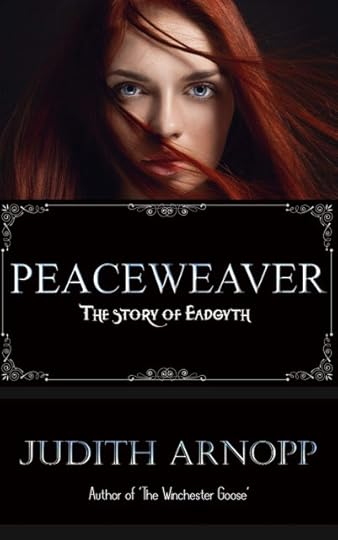
When AElfgar, Earl of Mercia falls foul of King Edward the Confessorm Aelfgar forms an alliance with an old enemy, Gruffydd ap Llewelyn of Wales and to cement the alliance, offers his daughter, Eadgyth as Gruffydd’s wife.Gruffydd is old enough to be Eadgyth’s grandfather, and the union is not a happy one. Eadgyth does her best to survive a life of exile but ultimately finds herself accused of fornication, incest and treason.Alone in a foreign land, her life is forfeit until Gruffydd is killed during a surprise night attack by Earl Harold of Wessex, and Eadgyth is taken as his prisoner to the court of Edward the Confessor.At the Saxon court she infiltrates the sticky intrigues of the Godwin family, and on the eve of his accession to the English throne, agrees to marry Harold Godwinson.As William the Bastard assembles his fleet in the south, and Harald Hardrada prepares to invade from the North, their future is threatened, and the portentous date of October 14th, 1066 looms.Eadgyth’s tale of betrayal, passion and war highlights the plight of women in Anglo Saxon Britain.
ExcerptChester 1070
We watched him ride past today, the one they are calling The Conqueror. Eadgytha and I saw him ride through the city gate and, although he is just a man, I buried the faces of my young sons in my skirts to shield them from the sight. They did not see the sneer of the squint-eyed king as he clattered by, or the gaudy splash of colour cast by the splendour of his retinue against the sombre street.
Around us, the crowd stood silent in the rain, and although I am tall and feared that the hatred in my heart would knock him from his mount, the counterfeit king did not notice me.
The people dispersed slowly, muttering against the ravages of the Norman dog who, having laid waste to the south and north of England, now turns his attention to Chester, our place of refuge and the last Saxon stronghold. Many have been slaughtered and their homes destroyed, leaving ruins to smoke beneath the sulky sky and the destitute to huddle in the darker places of the street.
A ragged old fellow snorted and spat greenly into the mud where the Norman king’s horse had trod. “God’s curse be on ye, gutter shite,” he cried in cracked tones, shaking his feeble fist in the air. I patted his arm in mute sympathy before we turned away.
“Why are you trembling, Mother?” asked Harold as we hurried back to our lodging, heads bent against the driving rain.
“Your mother is chilled, that is all,” replied Eadgytha, hastily taking the child’s hand. “We have stood too long in the rain. Come, hurry along, Harold; make haste, Wulf.”
We climbed the steep castle hill, inhaling the acrid stench of fires newly quenched by sheeting rain.
Too close to the stronghold for comfort now it is in Norman hands, we need to move on. Chester is no longer a safe refuge for any Saxon, let alone women such as we.
Indoors, the fire has sunk low. Eadgytha stoops to feed it a few meagre sticks before warming a little goat’s milk for a nourishing drink. Then we sit knee to knee before the hearth, while the twins play with swords fashioned from two sticks. Anwen bursts through the door, accompanied by a flurry of wind and leaves.
“My, it’s cold out there. I’ve managed to find a few things for supper, nothing to drool over but better than nothing. I’ll get it going right away so we can dine and get ourselves early to our beds.”
She throws vegetables into a pot while Eadgytha and I, chilled more by circumstance than weather, begin to discuss our options. The invasion has been thorough and there are few places of refuge left in England. No Saxons are content beneath the Norman rule yet; most, eager to save their necks, collaborate, quelling their hatred to meekly bear the yoke.
A few have rebelled. Some rally to the call of Hereward, known as the Wake, in his hiding place in the Fens. Perhaps we should join them there but it is a far off place, haunted by the dispossessed, and the marshes are fraught with mischievous sprites; besides, there is no man now to protect or guide us. So we cower here in this dark place, two women alone. Our household is scattered and we are forced to look to ourselves.
It is not easy for women such as we to live in obscurity, raising our children and scratching a living from the dirt. Eadgytha’s sons are far away and her daughters are … well, we know not where. My family is scattered also; my older sons are across the dyke with their Welsh kin, and my brothers are lost.
We make an odd pairing, Eadgytha and I, but we have only each other now. Of all the women in the land, we are the two whom William of Normandy most desires to lay hands upon. If we are captured, he will put out our eyes and cut off our noses. If we are lucky, we may be shut away in a religious house, but my infant sons will be shown no mercy. He will kill them straight.
There is no one in this stricken land who flees King William more diligently than we, for Eadgytha, long time known as the Gentle Swan, was twenty years King Harold’s mistress, and I, also named Eadgyth, was Harold’s queen. I am mother to the Ætheling, Harold Haroldsson, who tumbles in play with his brother upon the dusty floor.
Pick up your copy of
Peaceweaver
Kindle • Paperback
Judith Arnopp
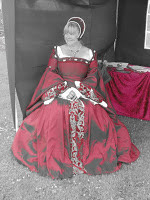 Judith Arnopp is the author of ten historical novels including The Winchester Goose, The Beaufort Chronicle (three book series), The Kiss of the Concubine and A Song of Sixpence. You can find her on Facebook • Twitter • Website • Blog.
Judith Arnopp is the author of ten historical novels including The Winchester Goose, The Beaufort Chronicle (three book series), The Kiss of the Concubine and A Song of Sixpence. You can find her on Facebook • Twitter • Website • Blog.
Published on October 29, 2019 21:00
October 28, 2019
Join #HistoricalFiction author, Brook Allen, as takes a look at "The Man Behind the Myth: Marc Antony #amwriting #AncientRome @1BrookAllen
One of the most frequently asked questions I get is “Why are you writing about him?” Others shake their heads, commenting, “That story has been told too many times.”So, why HIM? Why Marcus Antonius—more commonly known as Marc Antony? I have known since I was a Sophomore in high school that I wanted to write on the 1stcentury BC and focus on Rome. Fourteen years ago, when this project’s first chapter began, I chose Antony because other people had written so many times on Cleopatra and Caesar. Robert Harris had just started his well-researched books on Cicero. Antony seemed to be the only one left untouched. So I started writing. I’m sure glad I did. Antony’s life was full of drama, action, and tragedy. First of all, he lived through the Spartacan revolt, the Catiline conspiracy, was a cousin to Julius Caesar, probably met Cleopatra before Caesar ever did, helped restore her father’s throne, became Caesar’s second-in-command, gave the world’s most famous funeral oration, and later married Cleopatra. And that’s just for starters.Whew! Perhaps you can see why he’s such fun to write about.As far as I know, my trilogy will be the first historical fiction work (at least in fifty some odd years) to focus on Antony’s life from his perspective. There have been other non-fiction biographies done on his life and times. The two mainstays being by Eleanor Goltz Huzar and Patrician Southern. Why other historical fiction authors haven’t jumped on this guy’s story is BEYOND me. Granted, he had a larger-than-life personality, truly became a legend, and was as impulsive in decision-making as a squirrel crossing the road in front of a truck! But here was theman who became the very catalyst transforming Rome from Republic to Empire. Why did he do the things that he did? Binge-drinking, womanizing, and at the end, choosing the East over Rome. Author Patricia Southern’s eye-opening biography, Mark Antony: A Life, really helped me grasp something. To paraphrase her words, she explained that “Antony never saw Rome’s Republic work properly.” Now, that statement isn’t an excuse. It’s pure fact. He was born and raised in the Republic’s death-throes. His grandfather was beheaded by the general Marius. The dictator Sulla instituted a Caligula-like reign of terror over the city when Antony was a baby. Why, the Senate was already becoming impotent before Caesar, Antony and Octavian ever set foot in the Curia.For years now, I’ve spent time and money going back and forth to the Mediterranean, trying my best to place myself in a position to feel Antony’s life and times. Four years ago, I stood atop the great theater in Philippi, overlooking the battlefield where he faced off with Brutus and Cassius, Caesar’s assassins. To see the breadth and scope of a battlefield that once held almost two-hundred-thousand legionaries locked in civil war, was mind-boggling. In fact, it made such an impression on me, that I wrote Antonius: Second in Command’s final scene from that perspective—at the top of the theater. I invite you to come along for one of history’s most complicated, insightful, and adventurous histories, by reading the Antonius Trilogy.Join me in discovering the man behind the myth.
Second in Command
By Brook Allen
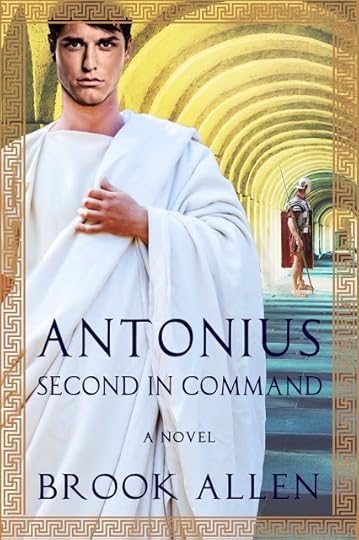
The Antoniussaga continues…
After proving himself as a formidable cavalry commander, Marcus Antonius finally earns a position at his kinsman Julius Caesar’s side. However, Caesar is an exacting general, demanding complete allegiance from his staff, even when his decisions put him at odds with the Senate. Marcus’s loyalty to Caesar comes at a cost, and he soon finds himself embroiled in mob violence and military mutinies. As civil war brings Rome’s Republic crashing down, many a relationship is torn asunder, including Marcus’s marriage. Determined to rise triumphant in Rome’s new era, Marcus faces his fears, his failures, and his enemies—not the least of whom is himself.Amid the crisis of the Ides of March, Marcus must don the mantle of ruthlessness to carve his own legacy in Rome’s history. Enemies have been made, wills have been read, and heirs proclaimed.But in Rome’s civil unrest, blood answers only to blood.
Excerpt
Marcus Antonius was going to be a father. Such thrilling news jumbled his emotions as he walked through the pouring rain, chewing his lip distractedly. A stray dog barked, chasing some geese and causing Marcus to detour, hopping over a puddle and then dodging a heaping pile of manure on the road. Tender scar tissue from a battle wound on his left calf constricted his quick movement, as it sometimes did. He grimaced, wiped water from his face, and kept moving. Damned wound had taken forever to heal.Outside Rome’s walls, wagons sat idly in long queues along the Via Appia. Drenched drivers hunkered down under layered clothing, miserably awaiting sundown, when they’d finally gain entrance. Due to overcrowding, carts only had access at night. Several miles’ worth sat in a stagnant line as far as the eye could see. Loaded with grain, amphorae, and reeking animal crates, their goods were piled precariously high.Marcus kept to the footpath alongside the road as a string of chained slaves trudged by, barefoot in the mud. Packs of grubby-faced children scurried from the footpath and shimmied between stationary wagons. They lived among the tombs and lofty monuments lining the Via Appia. Whenever traffic was idle, they seized the opportunity to hawk cheap wine, sausages, and boiled eggs, but they were just as apt to steal. Considered pests by most, they were the progeny of lowborn prostitutes who sold themselves day and night along this stretch of the Via Appia. Not much farther ahead was the Antonii tomb, where the urns of Marcus’s father, grandfather, and other ancestors rested. He craned his neck around the traffic and adjusted the wineskin hanging from his shoulder. A towering stand of pines separated the road from more monuments. He entered the woods and was promptly smacked in the face by two heavy branches, pelting him with more runoff. But now he was on a path he’d followed so often he could have walked it blind. Amid more tombs, it wound through a lovely grove where a modest stele marker stood. He stopped stock-still, heart in his throat. There it was.Even after four years, each visit wrenched his heart. Tears were already stinging his eyes. Had she really been gone so long? It seemed only yesterday when he’d made love to her, kissing her and stroking her hair. Never had skin felt so soft, so supple—so alive.Marcus stepped forward, reverently pulling his cloak over his head. His hand quivered slightly as he uncorked the wine. He tilted the skin over the stele’s offering holes, carefully pouring hislibation. Emotion followed, as it always did. Tears he’d been holding back on the road fell freely. Saturated and heavy, his hood slid off sideways, rain dripping down his face once more. His fingers skirted the rough edges of the stone, caressing it, wishing it were Fadia. He leaned forward until his forehead rested against its cold granite.“I still love you,” he whispered to Fadia’s shade. “I still miss you. Much has happened since I held you last. I’m to be a father. But it won’t be the same. I wish it was our child growing up to bear your image or mine. I wish it with every breath.” Today was no different from other days spent at her stele. He’d pour his heart out to her and then leave feeling baffled and depressed. Four long years had passed. Marcus had remarried, which had been inevitable. Time moved on. So why was he so miserable? Granted, it was rare when any man of his social status truly loved his wife. Yet many men still enjoyed themselves, making excellent husbands and fathers. His wife and cousin, Antonia, was every bit as kind as Fadia had been. She was good to everyone with whom she came into contact, and her green eyes sparkled with love whenever he was near. Marcus recalled when he was little how Mother used to exclaim, “That Antonia! With her red hair and freckles, she looks like a Gallic chieftain’s daughter.” Mother treasured her. She had even decided that, after all was said and done, Marcus had made a good match with Antonia. Household slaves adored her too. On their wedding day, they had taken extra time, festooning flower swags to make their new domina beam with shy smiles.
So why, oh why didn’t Marcus feel anything for her? Whenever they were together, his heart was still as stone—not uncaring, but numb, as though it lay dead inside.
Coming soon…
Brook Allen
 Brook Allen has a passion for ancient history—especially 1st century BC Rome. Her current work is a trilogy on the life of Marcus Antonius—Marc Antony, which she has worked on for the past fourteen years. The first installment, Antonius: Son of Rome was published in March 2019. It follows Antony as a young man, from the age of eleven, when his father died in disgrace, until he’s twenty-seven and finally meets Cleopatra for the first time. The newest book is Antonius: Second in Command, dealing with the Antony’s tumultuous rise to power at Caesar’s side and culminating with the tumultuous civil war against Brutus and Cassius.In researching the Antonius Trilogy, Brook’s travels have led her to Italy, Egypt, Greece, and even Turkey to explore places where Antony once lived, fought, and eventually died. While researching abroad, she consulted with scholars and archaeologists well-versed in Hellenistic and Roman history, specifically pinpointing the late Republican Period in Rome. Brook belongs to the Historical Novel Society and attends conferences as often as possible to study craft and meet fellow authors. Though she graduated from Asbury University with a B.A. in Music Education, Brook has always loved writing. She completed a Masters program at Hollins University with an emphasis in Ancient Roman studies, which helped prepare her for authoring her present works. Brook teaches full-time as a Music Educator and works in a rural public-school district near Roanoke, Virginia. Her personal interests include travel, cycling, hiking in the woods, reading, and spending downtime with her husband and two amazing Labrador Retrievers. She lives in the heart of southwest Virginia in the scenic Blue Ridge Mountains.
Brook Allen has a passion for ancient history—especially 1st century BC Rome. Her current work is a trilogy on the life of Marcus Antonius—Marc Antony, which she has worked on for the past fourteen years. The first installment, Antonius: Son of Rome was published in March 2019. It follows Antony as a young man, from the age of eleven, when his father died in disgrace, until he’s twenty-seven and finally meets Cleopatra for the first time. The newest book is Antonius: Second in Command, dealing with the Antony’s tumultuous rise to power at Caesar’s side and culminating with the tumultuous civil war against Brutus and Cassius.In researching the Antonius Trilogy, Brook’s travels have led her to Italy, Egypt, Greece, and even Turkey to explore places where Antony once lived, fought, and eventually died. While researching abroad, she consulted with scholars and archaeologists well-versed in Hellenistic and Roman history, specifically pinpointing the late Republican Period in Rome. Brook belongs to the Historical Novel Society and attends conferences as often as possible to study craft and meet fellow authors. Though she graduated from Asbury University with a B.A. in Music Education, Brook has always loved writing. She completed a Masters program at Hollins University with an emphasis in Ancient Roman studies, which helped prepare her for authoring her present works. Brook teaches full-time as a Music Educator and works in a rural public-school district near Roanoke, Virginia. Her personal interests include travel, cycling, hiking in the woods, reading, and spending downtime with her husband and two amazing Labrador Retrievers. She lives in the heart of southwest Virginia in the scenic Blue Ridge Mountains. Connect with Brook: Website • Amazon • Twitter • Facebook.
Published on October 28, 2019 20:30
The Coffee Pot Book Club Book Cover of the Month for October is — Wanders Far by David Fitz-Gerald @AuthorDAVIDFG @hfvbt

The Coffee Pot Book Club
Book Cover of the Month
Goes to...
Wanders FarBy David Fitz-Gerald

Wanders Far lived in dangerous times and was faced with one difficult challenge after another. He was a skinny, quiet boy who was raised on the banks of a tributary of New York State’s Mohawk River, hundreds of years before colonists arrived. One lifetime was not enough for Wanders Far’s old soul.From a very young age, his wanderlust compelled him down one path after another. No village could contain him.He was happy living a simple life in the physical world during challenging times. The spirit world had other plans.A wise, enigmatic shaman mentored Wanders Far and helped him cultivate the supernatural visions that haunted him. His guide could only help him so far.He set out to become a runner, carrying important messages across the lands of his people and their enemies. He ended up fulfilling a much greater destiny than he ever imagined. “This engrossing, well-written novel tells the story of a pivotal moment in Iroquois history through a well-traveled protagonist.”
Kirkus Reviews
Pick up your copy ofWanders FarAmazon UK • Amazon US
David Fitz-Gerald
 After a chaotic day as a business person, Dave enjoys getting lost in the settings he imagines and spending time with the characters he creates. Writing historical fiction is like making paintings of the past. He loves to weave fact and fiction together, stirring in action, adventure, romance, and a heavy dose of the supernatural with the hope of transporting the reader to another time and place. He is an Adirondack 46-er, which means he has hiked all of the highest peaks in New York State, so it should not be surprising when Dave attempts to glorify hikers as swashbuckling superheroes in his writing.Wanders Far—An Unlikely Hero’s Journey is the first in a series of books in the Adirondack Spirit Series.
After a chaotic day as a business person, Dave enjoys getting lost in the settings he imagines and spending time with the characters he creates. Writing historical fiction is like making paintings of the past. He loves to weave fact and fiction together, stirring in action, adventure, romance, and a heavy dose of the supernatural with the hope of transporting the reader to another time and place. He is an Adirondack 46-er, which means he has hiked all of the highest peaks in New York State, so it should not be surprising when Dave attempts to glorify hikers as swashbuckling superheroes in his writing.Wanders Far—An Unlikely Hero’s Journey is the first in a series of books in the Adirondack Spirit Series.Connect with David
WEBSITE • FACEBOOK • TWITTER • GOODREADS • BOOKBUB • INSTAGRAM
Published on October 28, 2019 09:54
October 27, 2019
Historical Fiction author, Pam Lecky, is talking about Historical Novel Research #amwriting #HistoricalFiction @pamlecky
Historical Novel Research
By Pam Lecky
The research required when writing historical tales can be daunting. Happily, I love it, and over the years my collection of reference books has grown. The genre requires a writer to explore practically everything in their chosen period from idioms used, to mourning protocols. As my era of choice is the late Victorian/early 20thcentury, my library includes Mrs Beetons Book of Household Management (with hilarious cures and advice, by our modern standards), Bradshaws 1895 Railway Timetable, and one of my favourites - The Poisoner’s Handbook! These particular tomes have been invaluable. My current work in progress, the second book in the Lucy Lawrence Murder Mystery Series, is set in Victorian Egypt. As I have always been fascinated by Ancient Egypt, it was inevitable my unfortunate heroine would end up there. Finding contemporary descriptions is the ultimate goal, and I was fortunate enough to come across Amelia Edwards’ A Thousand Miles up the Nile on a visit to the British Museum. Her travel memoir was written a decade before I set my novel. Fortune smiled on me once more when I found a scanned online version of the Baedeker’s Guide to Lower Egypt, published in 1885, two years before my heroine lands in Alexandria. These two books provided accurate detail and gave me an insight in how the Victorians behaved when on their travels. Then, as I delved into the history of Victorian Egyptology, I uncovered the animosity which existed between the British and French archaeological teams. I knew immediately this was a scenario I could exploit in Footprints in the Sand, with the added satisfaction of being able to use the glorious setting of ancient Egyptian monuments.

No Stone Unturned, which was published a few months’ ago, is the first novel in the series and it often threw up some interesting questions for me. For instance, did Victorian households use rubbish bins? What was the nearest mortuary to Vine Street Police Station in London? What type of train ran in the London Underground in 1886? My collection of research books failed me, as did Amazon and Google.
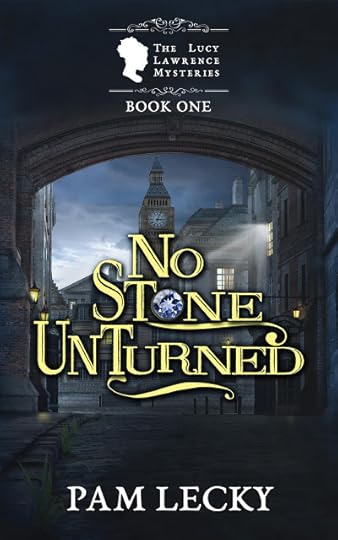
Since the publication of my first novel in 2015, I have discovered that contacts online can be a useful source of information when you hit a research wall. Lee Jackson, a fellow historical fiction author, has written extensively on Victorian life and several of his non-fiction books are on my shelves. I contacted him on Twitter and he was able to tell me what I needed to know about Victorian rubbish and its disposal. And, within half an hour he had come back to me with the name of the mortuary that would have been closest to the police station in 1886, i.e., Dufour Place (sadly no longer in existence - well, sad for me as I would have liked to have visited it!). The train question was a little trickier as I also wished to know how long a particular journey took. Thankfully, I found the London Transport Museum online, and within 24 hours I had not only answers to my questions but copies of relevant timetables. To my astonishment, they used steam trains on the Victorian underground in those early days. As I delved deeper, I discovered that the engineers hadn’t allowed for ventilation in the tunnels and this had to be retro-fitted, much to the relief of the commuters, I’m sure.But what to do with all this wonderful background information? It is imperative to get the balance right between creating authentic settings, characters and believable plots, while not boring your reader with the minutiae. So, unfortunately, most of it does not end up in the novel. However, as a writer I could not create without it. The information gleaned from all these sources helps me get inside the heads of my characters, enabling me to see their world through their eyes. But of even greater importance, many of my sub-plots and ideas have sprung from the very fertile soil of research. As a backdrop to the mystery element of No Stone Unturned, I also wanted to explore how a relatively young Victorian woman, with a strong personality and high intellect, would cope within the confines of a troubled marriage. Would she accept her lot or chafe at the bit? But, in Lucy’s case, with no money and estranged from her family, she could not walk away. To do so, would mean social ruin. However, when circumstances finally release her (her husband’s sudden death), she struggles to cope. Pretty much every man in her life so far has betrayed her on some level for their own ends. There is a pivotal scene in the story when Lucy realises she must shape her own destiny, and she sets out on a dangerous adventure in pursuit of the truth about her late husband and his less than legal activities. To make this believable would have been impossible without doing the research into Victorian women’s lives: Lucy had to be a woman of her time.But, you may wonder, how can you bear not to use all this lovely information? And I felt the same and pondered the question for some time. Then it struck me that a series of blog posts based on the research would make the perfect pre-launch material. This worked very well for me and helped boost my pre-order sales, via my website.There is nothing more jarring for a historical fiction fan than historical inaccuracy. Most will not give you a second chance if you get it wrong. As a writer, you owe it to your readers to put in the hours and effort to get your basic facts correct. Think of it as quality control for your brand. Luckily, next to actually writing, I enjoy chasing down wispy threads and popping down rabbit holes: you never know what juicy nuggets of information you may discover!And just in case you are interested, the Victorians did use domestic rubbish bins which were collected by dustmen in horse-drawn carts twice a day - now that’s service!
No Stone Unturned
By Pam Lecky
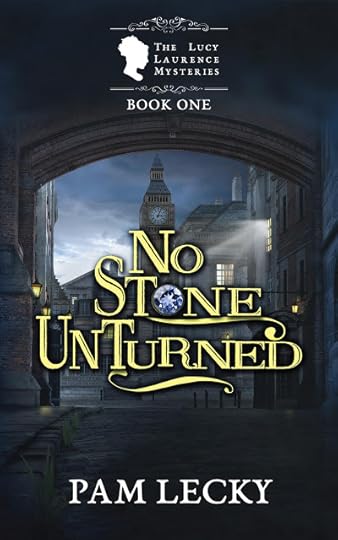
A suspicious death, stolen gems and an unclaimed reward:who will be the victor in a deadly game of cat and mouse?London October 1886: Trapped in a troubled marriage, Lucy Lawrence is ripe for an adventure. But when she meets the enigmatic Phineas Stone, over the body of her husband in the mortuary, her world begins to fall apart.When her late husband’s secrets spill from the grave, and her life is threatened by the leader of London’s most notorious gang, Lucy must find the strength to rise to the challenge. But who can she trust and how is she to stay out of the murderous clutches of London’s most dangerous criminal?
Pick up your copy ofNo Stone Unturned
Amazon UK • Amazon US
Pam Lecky
 Pam Lecky is an Irish historical fiction author, writing crime, mystery, romance and the supernatural. Pam is represented by the Hardman & Swainson Literary Agency in London. She is a member of the Historical Novel Society and the Society of Authors and has a particular love of the late Victorian era/early 20th Century.Her debut novel, The Bowes Inheritance, was awarded the B.R.A.G Medallion; shortlisted for the Carousel Aware Prize 2016; and long-listed for the Historical Novel Society 2016 Indie Award.Her short stories are available in an anthology, entitled Past Imperfect, which was published in April 2018.June 2019, will see the release of the first book in the Lucy Lawrence Mystery series, No Stone Unturned, a fast-paced Victorian mystery/crime, set in London and Yorkshire. The sequel, Footprints in the Sand will be released later this year.Connect with Pam:Website • Amazon • Facebook • Twitter • Instagram
Pam Lecky is an Irish historical fiction author, writing crime, mystery, romance and the supernatural. Pam is represented by the Hardman & Swainson Literary Agency in London. She is a member of the Historical Novel Society and the Society of Authors and has a particular love of the late Victorian era/early 20th Century.Her debut novel, The Bowes Inheritance, was awarded the B.R.A.G Medallion; shortlisted for the Carousel Aware Prize 2016; and long-listed for the Historical Novel Society 2016 Indie Award.Her short stories are available in an anthology, entitled Past Imperfect, which was published in April 2018.June 2019, will see the release of the first book in the Lucy Lawrence Mystery series, No Stone Unturned, a fast-paced Victorian mystery/crime, set in London and Yorkshire. The sequel, Footprints in the Sand will be released later this year.Connect with Pam:Website • Amazon • Facebook • Twitter • Instagram
Published on October 27, 2019 21:00
Top writing tips from Andrew Noakes, historical fiction editor #amwriting #HistoricalFiction #Editing @andrew_noakes
Top writing tips from Andrew Noakes, historical fiction editor
As an editor, no story I read is exactly the same. But there are certain mistakes – and, conversely, things that work well – that I often see repeating themselves. With that in mind, here are ten top writing tips, divided into five things to embrace and five things to avoid.

Embrace
1. A good story question. This is rule number one. From early on, it’s important to make it clear to the reader what your story is about and where it’s taking them. One way of approaching this is to establish a ‘story question’ – a fundamental question that you introduce in the first few chapters and that needs to be answered in the resolution. Throughout all of your story’s twists and turns, the story question then serves as the spine that holds everything together and provides a sense of direction. In a romance, it could be ‘will the protagonist and their love interest get together?’ In a mystery, it might be ‘who committed the murder?’ In an action story, it might be some variation of ‘will the protagonist defeat their enemies?’ Whatever form it takes, you can’t go wrong by giving your novel a good story question.
2. Show and tell. The common refrain of ‘show, don’t tell’ comes from a good place: ‘telling’ your reader too much denies them the opportunity to peel back the layers of your story and interpret things for themselves. But some telling is inevitable – and in fact vital for clarity and moving things along – so the advice should really be to show and tell. Use your ‘showing’ tools – most often action, dialogue, and internal thought – to provide the reader with an engaging experience, but don’t be afraid to use some good old narrative exposition when it’s called for.
3. Historical authenticity. Accuracy is a major concern in historical fiction. It’s vital to immerse historical fiction readers into a world that truly feels like the past, and often the best way to do that is to ensure things are as accurate as possible. But what happens when accuracy isn’t practical – or when it would be alienating to the reader? To take an obvious example, it would be accurate to write the dialogue in your Roman novel in Latin, but it probably won’t do you any favours with your readers! Here’s where historical authenticity comes into play. It’s about creating an authentic sense of the past, even if it’s not one hundred percent accurate. Language is a good example: by avoiding modern colloquialisms, focusing on neutral words and phrases, and including some archaic language too, you can usually create an authentic sense of historical language without it being so accurate that it’s hard to understand. If you’re looking for more tips on accuracy and authenticity in historical fiction, check out my in-depth guide here.
4. Stakes. You can have all the conflict and suspense you like, but if your plot doesn’t have stakes, it won’t maintain the reader’s attention for long. Stakes are what make your plot matter. And what are they exactly? They’re the consequences of the possible outcomes of your story. What’s the worst thing that could happen if your protagonist doesn’t achieve their story goal? And what’s the best thing that could happen if they do? The stakes are to be found in the difference between these possible consequences and what they will mean to your story world and characters. For instance, in The Lord of the Rings, Frodo’s goal is to destroy the One Ring, and the stakes are the consequences of success or failure: Middle Earth either being saved or conquered and subjugated. They’re compelling because they have major ramifications for the world and the characters, and because there’s a big gulf between the two possible outcomes.
5. Setbacks. To keep your reader interested, things need to go wrong in your plot – badly wrong. The protagonist’s journey cannot be a smooth one, marked by success after success. There have to be setbacks that complicate things and make it more difficult for them to achieve their goals, and these setbacks should get progressively worse as the novel goes on. If things just go too well, the story will feel predictable and unexciting. So don’t be afraid to let loose and give your characters a rough ride!
Avoid
1. An episodic structure. One problem I often encounter is an episodic structure. This is when a story doesn’t settle on one particular plot thread – or story question, as above – and instead tries to include multiple plot threads, one after the other. This isn’t the same as having side plots that relate to, and complement, a main plot that runs throughout the story. Instead, it involves starting one main plot thread, finishing it, starting another, finishing it, and so on until you reach the end. This can happen if you start a story and aren’t able to develop a sense of where it’s going, or if you find yourself struggling to sustain a plotline. Unfortunately, it’ll usually irritate your reader, ripping them out of plotlines just as they were starting to invest and leaving them unsure of what the story is about and where it’s trying to take them.
2. Too much setting. Setting is important, especially in historical fiction. It helps to immerse your reader into the period and give them a sense of what your world looks and feels like. However, don’t go overboard. Your task is to create an immersive sense of your setting, not to exhaustively describe every detail. One way of approaching it is this – when your point of view character enters an environment, what key details can you convey that will give your reader a sense of that environment? Perhaps, for example, in a banquet hall, it’s the smell of roasted meat, the sound of laughter, and the dim light. If you can flesh these particular details out a little bit, that may well be all you need. The reader’s imagination can then take over and do the rest. What you definitely shouldn’t do is exhaustively describe every single detail. If you do, it’ll prevent the reader from exercising their own imagination, while leaving you with insufficient room to actually tell the story.
3. Insufficient dramatisation. For a story to come alive, it needs to be dramatised. That means you need two things in particular: action and dialogue. Both of these create a sense of immediacy, a sense of now. They dramatise your story as if it were happening right in front of the reader. A novel can go badly wrong when it doesn’t contain enough of either, instead relying too heavily on long sections of narration, description, and internal thought to tell the story. These elements are essential, of course, but they don’t have the same sense of immediacy and dynamism that action and dialogue do, so don’t overuse them and drown out the dramatisation.
4. Stilted dialogue. There’s nothing quite like stilted dialogue to jar the reader out of your novel, so you need to avoid it at all costs. That can be easier said than done, though. We all know what stilted dialogue looks and sounds like, but it can harder to put your finger on exactly what’s causing it. Fortunately, there are a few little tips I can recommend: 1) Don’t shy away from contractions – they’re great for making dialogue sound more natural, 2) Avoid making your characters constantly repeat each other’s names when they’re talking – people don’t really do this, 3) Be realistic about how your characters would express their emotions – people can be very complex, subtle, and evasive when it comes to expressing how they feel, 4) Use things like pauses, hesitations, and interruptions – these are all natural features of speech, 5) Use body language to augment dialogue, too (though don’t overuse it!).
5. Rushed denouement. Everyone knows the climax of a story is important. It’s where everything comes to a head and usually where the core issues in a story get resolved, or at least start to get resolved. But the bit that comes next is also very important: the denouement. This is the part where the action falls, you give the reader a chance to breathe and take in everything that’s happened, and you tie up any loose ends. Don’t rush through this part. If you do, your ending can feel too abrupt, and your story incomplete.
So, there you are. Five things to embrace and five to avoid. Of course, few rules in fiction are universal, but you can’t go far wrong with these ones.
Andrew Noakes
 Andrew Noakes is a specialist historical fiction editor. He is founder and executive editor of The History Quill, which provides dedicated support to historical fiction writers at every stage of the writing process. They offer specialist historical fiction editing, coaching programmes, and a wealth of resources tailored to the historical fiction genre. If you’re interested in more writing tips, check out their comprehensive guide on writing historical fiction, How to write historical fiction in 10 steps.
Andrew Noakes is a specialist historical fiction editor. He is founder and executive editor of The History Quill, which provides dedicated support to historical fiction writers at every stage of the writing process. They offer specialist historical fiction editing, coaching programmes, and a wealth of resources tailored to the historical fiction genre. If you’re interested in more writing tips, check out their comprehensive guide on writing historical fiction, How to write historical fiction in 10 steps.
Published on October 27, 2019 19:00
The Coffee Pot Book Club
The Coffee Pot Book Club (formally Myths, Legends, Books, and Coffee Pots) was founded in 2015. Our goal was to create a platform that would help Historical Fiction, Historical Romance and Historical
The Coffee Pot Book Club (formally Myths, Legends, Books, and Coffee Pots) was founded in 2015. Our goal was to create a platform that would help Historical Fiction, Historical Romance and Historical Fantasy authors promote their books and find that sometimes elusive audience. The Coffee Pot Book Club soon became the place for readers to meet new authors (both traditionally published and independently) and discover their fabulous books.
...more
...more
- Mary Anne Yarde's profile
- 159 followers



